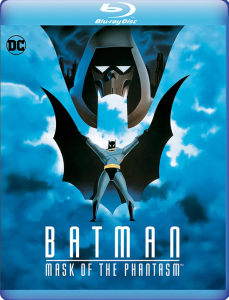“Batman: Mask of the Phantasm” (1993), like most animated films based on properties best known for live action, made only a blip at the box office. (See also 2008’s “Star Wars: The Clone Wars” movie.) It was released on Christmas Day 1993 to tide Bat-fans over between 1992’s “Batman Returns” and 1995’s “Batman Forever,” and it’s regarded by many as being better than all of the 1990s live-action entries.
Gateway to animated world
Although this film doesn’t mark the debut of “Batman: The Animated Series,” which launched on TV a year earlier, “Phantasm” is a perfect introduction to that world. It’s the length of four episodes, but it’s not a stitched-together four-parter; the story flows smoothly in a noir detective style.
And in the expected fashion of that genre, Bruce Wayne/Batman (Kevin Conroy) is down in the dumps here. Flashbacks to a few years earlier show us what might have been his first true love, Andrea Beaumont (Dana Delaney), who has striking red hair but won’t be confused with Poison Ivy. Their love story is simple but pure under the pen of four writers working from Alan Burnett’s story.

“Batman: Mask of the Phantasm” (1993)
Directors: Eric Radomski, Bruce Timm
Writers: Alan Burnett (screenplay, story); Paul Dini, Martin Pasko, Michael Reaves (screenplay)
Stars: Kevin Conroy, Dana Delany, Hart Bochner
In a stark contrast to the womanizing but ultimately loner Bruce from the live-action films, this Bruce loves Andi. The fact that she knows he’s Batman is an effective shorthand for their closeness. In one of “Phantasm’s” best scenes, he stands before the grave of his parents and wonders if he’s done enough crimefighting – if he can now live a happy life with Andi and simply give money to the Gotham City Police Department to hire more officers.
Burnett’s team draws from “Batman: Year One” (1987) in that they show a flashback to Batman’s first fight, when he has a mask but not a cape and cowl. The lesser known “Batman: Year Two” (1987) comic is also cribbed from: The Phantasm is based on that story’s Reaper.
Style in place
The “Animated Series” style is in place as I fondly remember it from weekday after-school viewings back in the day. Gotham seems empty – perhaps a limited-budget necessity — yet also foreboding, leaving plenty of shadows for the bad guys to hide in.
Several mobsters come out to play, including one in the opening scene who announces his plan to counterfeit money and launder it through his casino. (This is a prime example of how the series wrote to kids – who would understand at least the counterfeiting – and adults – who would grasp the laundering.)
Also emerging from the woodwork is the Joker (Mark Hamill), whose laughter is a bit much. I’ve always admired Hamill’s performance rather than loved it, although it’s pointless to complain about the Joker being over-the-top. I love the Joker’s lair here, in a broken-down World of Tomorrow exhibit from a past Gotham World’s Fair. This retro vision of the future — high-speed rails and robot kitchen help — is based on the 1939-40 New York World’s Fair.

The ruined World of Tomorrow is a nice encapsulation of Gotham, an out-of-time city that on the other hand can feature modern or even futuristic technology. Batman has a huge computer screen in the Batcave and internet access, and he’s also plugged into companies’ and agencies’ internal systems. (In my head, “The Animated Series” is set in an alterna-1993.)
The abandoned structures symbolize the lost hope of what Gotham could have been, and what some – like Bruce — hope it can still be. Indeed, another slight reference to “Year One” finds Batman fleeing through a shell of a building as Detective Bullock (Robert Costanzo) and the police try to gun him down, thinking he’s committing the vigilante-justice killings of the Phantasm (Stacy Keach).
Oddly evocative
All told, the animated Gotham is weirdly evocative; a lava-red sky doesn’t make any logical sense, but it’s somehow the right choice. More technically, the rain and wet window effects are totally believable.
Speaking of style, Shirley Walker’s score is what most jumped out at me. This is not one of those animated scores where three themes are continually recycled. This is sweeping orchestral stuff, and there’s even an old-Hollywood romance theme for Bruce and Andi. (In a fun bit of trivia, “Dark Knight” trilogy composer Hans Zimmer plays the synthesizer on the score.)
The end-credits song starts with appealing saxophone, although it ultimately ends up being a generic love ballad sung by Tia Carrere, who was on her way up via her turn in 1992’s “Wayne’s World.”
“Mask of the Phantasm” comes up enough in discussions of the great “Batman” works that I hoped for a deeper story. The truth is that this is still a 76-minute cartoon aimed at intelligent kids, with adults allowed to like it too.
It’s dripping with noir touchstones, but the narrative hits all the familiar tropes in unsurprising ways. The style is lush, though – clearly from 1993 yet made with enough care that it holds up today – and I can see why “Phantasm” is a favorite among Bat-fans.

